She feels really easy and comfortable to sail, even in a good breeze and a chop.

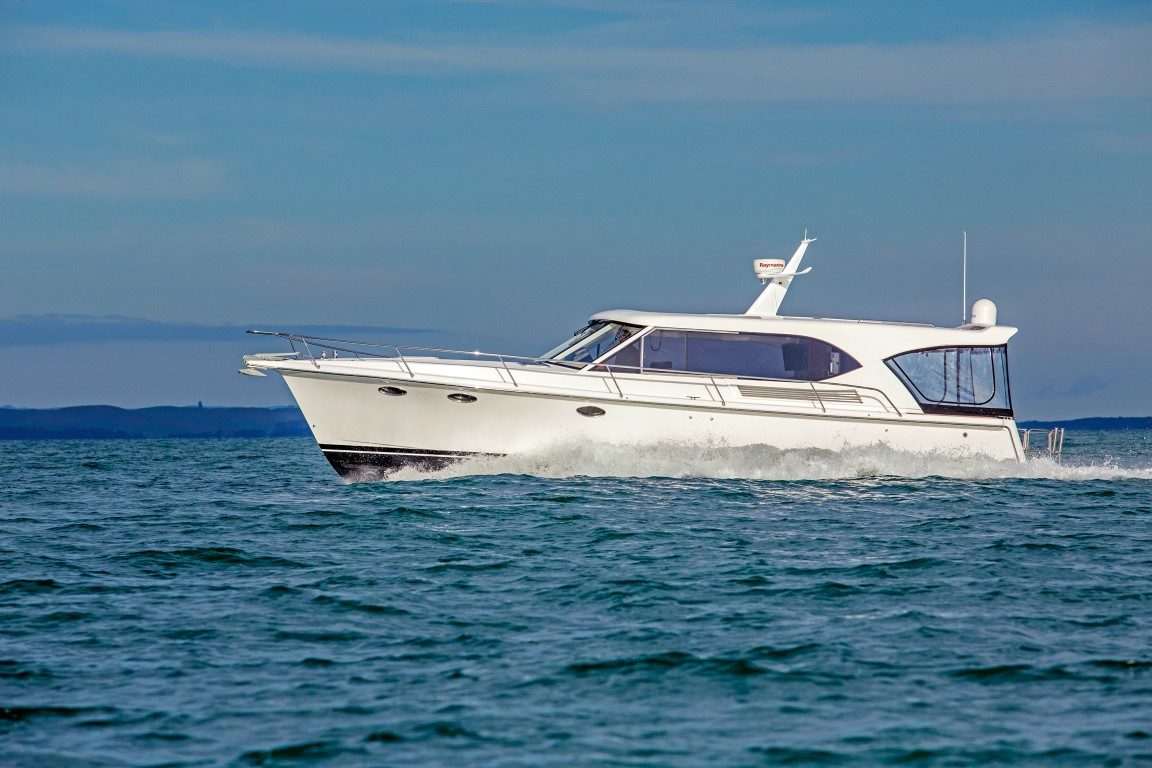
Reviewing a boat on a rough day is a rare experience, but with the photography already in the bag and another cyclone on the way, we decided to take our chances with the weather.
We joined the Salthouse Corsair Euro 44E Liquid Paradise on an overcast morning with a strengthening north-easterly piling up a respectable sea at the entrance to the Waitemata Harbour. And it was a revelation: in the conditions the vessel inspired confidence and delivered a remarkably comfortable, composed ride.
Pedigree
Dean and Treena Salthouse from Salthouse Next Generation Boats have enjoyed considerable success with the revamped and totally updated Corsair sedan range, a development of the original Salthouse Corsair designed over 50 years ago by Dean’s father Bob and produced in Mark I and Mark II versions.
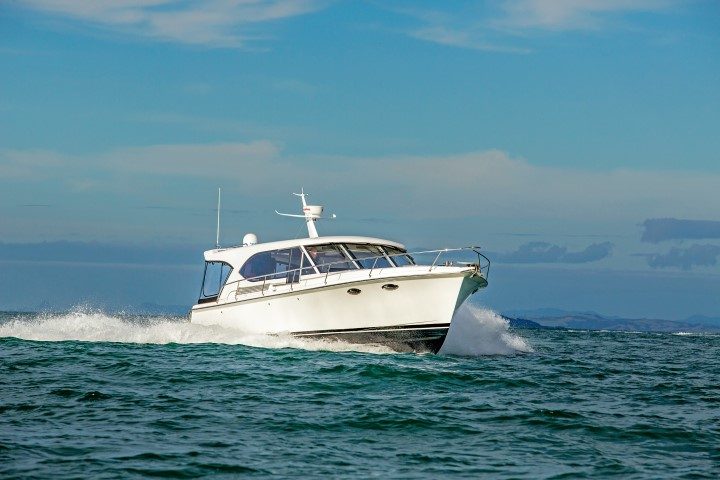
The Mark II hull was the starting point for current models. Dean and Bob spent two years developing the new Corsair, lengthening and widening the Mark II hull, adding a skeg keel and modifying the underwater sections for better bow lift. The first new Corsair was released in 2005.
Dean and Treena have sold 20 of the revamped Corsairs so far, 17 of them in New Zealand. Initially the boats were built at Next Generation Boats in Silverdale using traditional Kiwi boatbuilding methods, but in 2015 production shifted to the Hylas factory in Taiwan where a new team was formed to build boats for the international market in moulded GRP.

The Corsair comes in Euro and Cabriolet versions, both sedan-style launches with social, one-level layouts, sheltered cockpits and sleek styling. They are available in 44-foot (13.5m) and 49-foot (15m) versions. In Europe the Corsair 44E is sold as the Hylas 44.
Liquid Paradise is a Taiwan-built boat and she compares favourably with earlier New Zealand built examples. Moulding the boats in fibreglass, including the roof and cockpit overhang, has simplified the build process, reducing costs, and making them easier to maintain.
Liquid Paradise also dispenses with the electric cavity windows of earlier boats, along with a few other extras, to rein in the purchase price, but in most respects she lacks nothing: Northern Lights genset, factory-installed electronics, bow thruster, dinghy tender with outboard, and a full set of covers are all included in the price.
All-seasons space
Her interior is finished to a high standard, especially the woodwork, which easily meets Dean’s approval (he did his apprenticeship as a marine cabinet maker). Teak decks are 15mm thick and interior design is by Kiwi specialist Donna Marie Yacht Interior Design.
The Euro is a galley aft configuration with superb flow to the cockpit, which serves as an extension of the saloon. Wrap-around cockpit seating, a moulded cockpit table (converts to a sun lounger), full-length cockpit overhang and removable clears/cockpit covers create a cosy, all-seasons space. A diesel heater will keep the boat warm in winter.
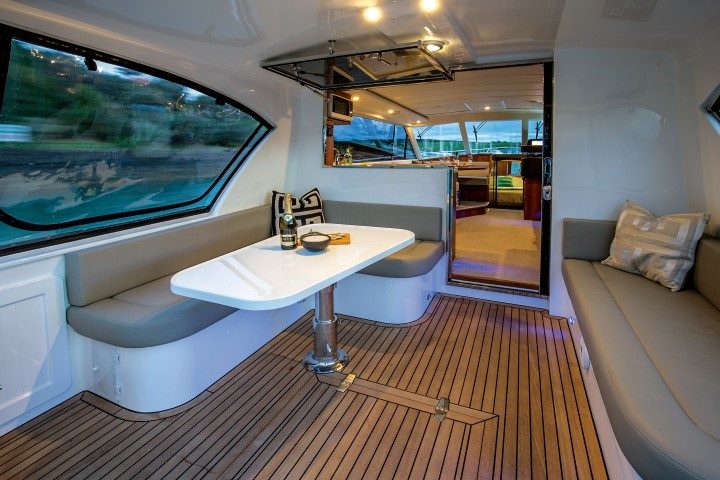
The swim platform works well for fishing and other water activities. An optional stainless-steel cage provides security, four rod holders and somewhere to mount the bait table; there’s a live bait tank set into the duckboard.
Across the transom, a sink and a built-in rubbish bin are handy when fishing and there’s a cockpit shower on the port side for rinsing off after a swim or a dive. The drop-down rod locker in the cockpit ceiling is a clever idea.
The vessel’s lazarette, accessed through a large hatch in the cockpit sole, is neatly laid out with plenty of space for dive bottles, the dinghy outboard and assorted gear. The vessel’s 900-litre fuel tank is accessed from the lazarette and there is additional storage under the cockpit seats.
Designer interior
Step into the saloon and an abundance of large windows flood the space with light. They provide plenty of ventilation too, with opening side windows, a simple, hinged rear window on gas stays and large sliding skylights overhead. On a good day the helmsman can sit on the back of the seat and poke his head through the hatch for a wind in the face experience. Sightlines are excellent, sitting or standing, at anchor or underway.
Liquid Paradise’s galley is well-appointed and tastefully finished with good quality cabinets, Hi Mac benches, a Thetford four-burner cooktop with oven (installed in NZ), electric microwave and two-drawer fridge. For its size, the galley boasts generous storage, including a pullout pantry, an in-bench freezer and a rubbish bin.
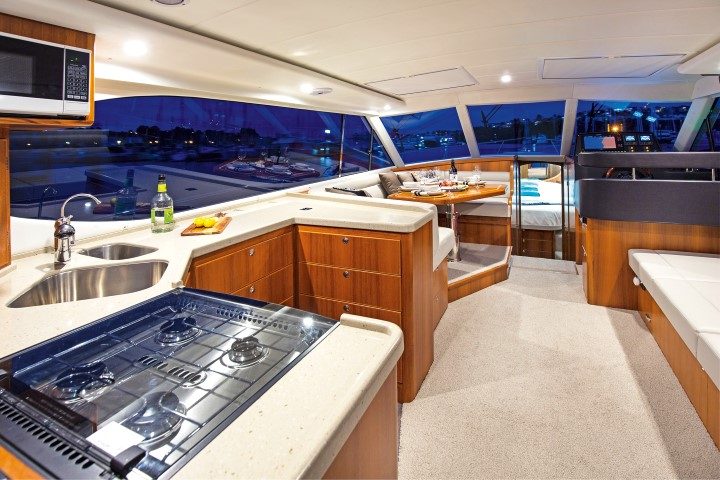
Donna Marie’s choices for the saloon decor are nicely understated. Vinyl roof lining complements well-chosen carpets (fitted in NZ) and leather upholstery. The flat-screen TV was sourced in New Zealand but fitted in Taiwan, as were the bow and engine room cameras and Hella LED lighting used throughout the vessel.
The overall layout is social and the starboard bench seat can serve duty as an extra berth if required.
Below decks a two-cabin floor plan affords a luxurious owners’ cabin and a guest cabin that can be configured with three single berths or a double and one single berth. The shared bathroom is well-appointed and has a separate shower cabinet.
The master cabin in the bow features an island berth with storage under, four port lights, a sunroof and plenty of locker space. Interiors are hand-built, just as they would be in New Zealand, says Dean, so there’s plenty of scope for customisation, but the vessel’s relatively narrow beam does limit overall volume.
Anywhere, any time
The Euro 44 is powered by a pair of 370hp Yanmar common-rail diesels. Engine room access is through the companionway stairs, which hinge up out of the way. There’s reasonable access to the machinery spaces and everything is neatly labelled, including skin fittings and sea cocks. Dean reckons there is still room for improvement in engine room detailing, but he’s a hard taskmaster. For major engine work, the saloon floor lifts out.
Twin Yanmars give the Corsair 30-knot-plus performance, but more importantly – as we found during this review – the boat can maintain 18 knots, an economical cruise speed, even in fairly unpleasant seas. We had 25 knots of northeasterly breeze and an opposing tide, but Liquid Paradise sliced through the head seas and tracked perfectly straight, surfing down the swells in following seas. As Dean pointed out, that means you can go anywhere, pretty much any time.
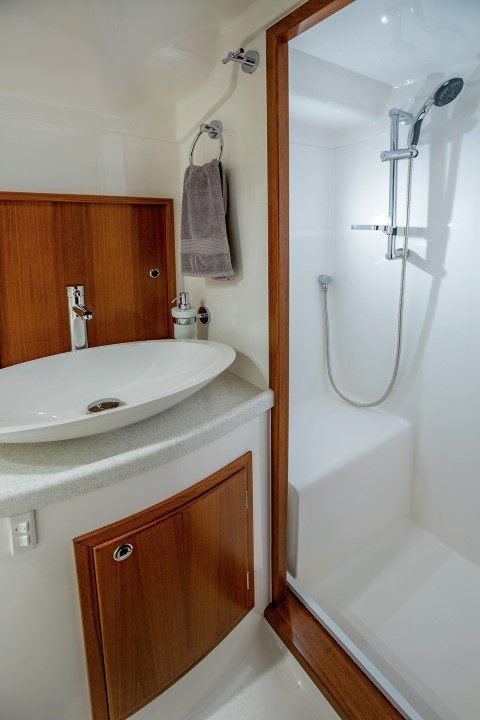
On a recent delivery voyage to Australia, a 49-foot Corsair carrying 2,000 litres of extra fuel in bags on deck was able to a maintain a cruising speed of 18 knots across the Tasman to Lord Howe Island. Even with nearly 3,000 litres of fuel and a full load of water aboard, the vessel still attained a top speed of 27 knots.
During our run it was noticeable that Liquid Paradise’s hull doesn’t pound. Dean demonstrated using the trim tabs to bring the bow down when travelling into a head sea, to take advantage of the vessel’s fine entry, and trimming it up again to free the hull for a faster, drier ride when running down swell. The skeg keel prevents any ducking or diving.
This vessel has twin rudders, but Dean has also experimented with a single rudder version, which he says is a little faster and suffers no appreciable loss of control when travelling down-swell.
Easy handling
In typical sedan style, Liquid Paradise only has a single helm station, but it’s well laid out. Custom wine racks, chart and wine glass drawers are cleverly integrated into the helm seat, which is wide enough for two at a squeeze. Electronics and autopilot are by Raymarine, trim tabs are by Bennett and anchoring is achieved from the helm, a Maxwell capstan doing the work – the bow camera means there is no need to go forward. Sidepower bow and stern thrusters help out at docking time.
Leaving from and returning to a tight berth next to the rock wall was remarkably stress-free, despite a low tide and plenty of wind. Dean set up the boat and the docking lines for single-handed berthing, which he ably demonstrated.
The gearbox ratios give the boat just four knots at idle, which is great inside the marina. The combination of two engines, twin rudders, skeg keel and thrusters ensured precise control at docking time, while the sliding helm door was handy when picking up and dropping lines.
Attractive proposition
In New Zealand and around the world, sedan styling and one-level living are becoming increasingly popular. By manufacturing Corsairs in moulded GRP, cost savings can be passed on to customers, while the ability to offer hand-built, customisable interiors sets the Corsair apart from production boats. They can also be manufactured to meet European (CE) or US standards, depending on the market.

Well-equipped and nicely presented, Liquid Paradise is easy to handle, easy to live aboard and easy to live with long-term. With the Corsair pedigree ensuring excellent performance and Salthouse Next Generation maintaining high standards of build quality and finish, Hylas-built Corsairs also benefit from sharp pricing.
She feels really easy and comfortable to sail, even in a good breeze and a chop.
At first glance the boat appears to be a large centre console, although hidden beneath the console and forward area is a sizeable overnight cabin.
With classic styling, good performance and class-leading ride and handling, there’s a lot to like about the Caribbean 32.
Solar panels on the vast roof help keep the batteries charged.